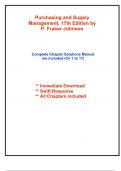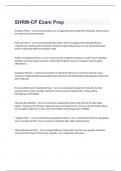Purchasing and Supply
Management, 17th Edition by
P. Fraser Johnson
Complete Chapter Solutions Manual
are included (Ch 1 to 17)
** Immediate Download
** Swift Response
** All Chapters included
, Chapter 1 EOC KEY
1. What is the profit-leverage effect of supply? Is it the same in all organizations?
The profit-leverage effect, covered in the section “Profit-Leverage Effect,” measures the profit impact obtained by a
decrease in purchase spend. A related concept is the return-on-assets effect. Good answers will be able to explain
the concept of profit leverage and understand how it is impacted by the amount spent on suppliers.
2. “Supply is not profit making; instead, it is profit taking since it spends organizational resources.” Do you
agree?
From a tactical perspective, supply does spend money on goods and services and incur expenses for the
administration of supply chain activities (e.g., salaries). However, good answers will be able to demonstrate the
opportunities for supply to contribute to organizational goals and strategies, operationally and strategically, and
directly and indirectly. The potential for the contribution of supply and the opportunities to extract competitive
advantage are explained in the section “Supply Contribution.”
3. What kind of decisions does a typical supply manager make?
There is an opportunity here for students to reflect on their own experiences, whether they have worked directly in
supply or have been exposed to supply activities while working in other functions. Examples of supply decisions are
described throughout the chapter and in the case studies in the book.
4. “In the long term, the success of any organization depends on its ability to create and maintain a
customer.” Do you agree? What does this have to do with purchasing and supply management?
Organizations exist to serve their customers. Without customers, organizations will not exist. In order to have
customers, firms must provide value. How organizations provide value to customers can differ by the nature of the
organization (refer to the section “The Nature of the Organization”) the potential for supply contribution is
explained in the section “Supply Contribution.” The challenges ahead for the supply professions are described in
the section “Challenges Ahead.”
5. Is purchasing a profession? If not, why not? If yes, how will the profession, and the people practicing it,
change over the next decade?
While there is not a definitive yes or no answer to whether purchasing is profession, it does have many of requisites,
as described in the section “Supply Qualifications and Associations.” It has associations with ethical standards and
established qualifications. Many universities have courses and programs in purchasing and supply management.
The challenges ahead for the supply professions are described in the section “Challenges Ahead.”
6. Differentiate between purchasing, procurement, materials management, logistics, supply management,
and supply chain management.
In some organizations, the nuances are subtle. The section “Purchasing and Supply Management,” provides
definitions and explains the meanings of these terms.
7. In what ways might digital technologies and e-commerce influence the role of supply managers in their
own organizations? In managing supply chains or networks?
,This question requires critical thinking on the part of the students to reflect on the impact of digital and e-commerce
technologies on both the role of supply and supply chains. The material covered in the section “Purchasing and
Supply Management” provides the foundation for this question. Comments about digital and e-commerce
technologies are covered in the introductory paragraphs and in the section “Technology.”
8. In the energy industry, the total purchase/sales ratio is 80 percent, while it is 60 percent in the food
industry and 25 percent in the financial services industry. Explain what these numbers mean. Of what
significance is this number for a supply manager in a company in each of these industries?
This question requires the students to reflect on the profit-leverage effect in the petroleum and coal products and the
food industries. The profit-leverage effect, covered in the section “Profit-Leverage Effect” measures the profit
impact obtained by a decrease in purchase spend. A related concept is the return-on-assets effect.
9. How does supply management affect return on assets (ROA)? In what specific ways could you improve
ROA through supply management?
The return-on-assets effect is covered in the section “Return-on-Assets Effect,” including an example in Figure 1-1.
10. How can the expectations of supply differ for private versus public organizations? Services versus goods
producers?
The role and expectations for supply are covered in the section “The Nature of the Organization.” Figures 1-3 and
1-4 provide summaries of the main differences for public sector and private sector organizations (including
manufacturing and services). Note that public sector organizations are primarily services-based.
11. In most organizations, the potential benefits of the indirect contribution of supply are greater than the
direct contributions. Do you agree? Why or why not?
See the section “Supply Contribution” and the section “The Indirect and Direct Contribution of Supply.” While the
direct contribution of can originate in several ways, it is much more difficult to measure than direct contributions.
12. What are the potential benefits of suppliers regarding your organization as preferred customer?
The section “Supply Contribution” explains the many ways that the supply function and suppliers can influence
organizational success. Asking students to explain what a “preferred customer” represents is a good starting point.
An important issue is recognizing that benefits in the buyer-supplier relationship flow both ways and preferred
customers are more likely to be the recipients of many benefits, ranging from capacity allocation during times of
shortage to early assess to innovative new products and services.
13. How can the supply function influence customer satisfaction?
The section on “The Direct and Indirect Contribution of Supply” includes areas where the function can influence
customer satisfaction, which is an indirect contribution, and refer to the section on the “Effect on Competitive
Position/Customer Satisfaction.” Examples include better quality, greater flexibility, and superior on-time delivery
performance.
14. Why should new managers consider working in supply as part of their training and development as
future leaders in their organization?
, Refer to the section “Training Ground” describing why and how supply experience represents a good training
ground for new managers.
15. How can the supply function expand its influence in an organization?
Refer to the section “Growth and Influence” discussing the growth and influence of the supply function. It describes
the four areas that provide opportunities: the percentage of the organization’s total spend for which it is
meaningfully involved, span of supply chain activities under purchasing or supply leadership, growth can occur in
the type of involvement of supply in what is acquired and supply chain responsibilities, and involvement in
corporate activities.





